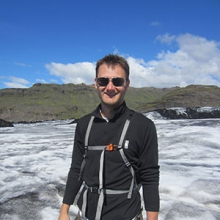-
Title
Staff Scientist -
Email
brennecka2@llnl.gov -
Phone
(925) 423-8502 -
Organization
Not Available
Research Appointments
- 2019 – present: Staff scientist – Lawrence Livermore National Laboratory
- 2014 – 2019: Institut für Planetologie, University of Münster
- 2013 – 2014: Postdoctoral Researcher – Lawrence Livermore National Lab – Nuclear Forensics Group
- 2011 – 2013: Postdoctoral Researcher – School of Earth and Space Exploration – Arizona State University
Research Interests
Greg Brennecka's research focuses on using chemical and isotopic signatures to unravel the formation and history of a sample. The majority of his work has been on the formation and early evolution of the Solar System by looking at meteorites to better understand supernovae injection into the protoplanetary disk, early Solar System conditions and their implications for the origin of life. Greg also has used isotopic signatures to study the history of oxygen in the ocean and its influence on various mass extinction events, as well as tracing the provenance of various materials.
Arizona State University – Isotope Geochemistry Ph.D., 2007-2011
University of Rochester – Nuclear Chemistry coursework, 2006
Oregon State University – Geochemistry/Ore Deposits M.S., 2003-2006
University of Missouri-Columbia – Geological Sciences B.S., 2000-2003
Columbia College – Natural Science/Chemistry B.S., 1998-2002
View ORCID and additional publications on Google Scholar.
Book Publications
Impact: How rocks from space led to life, culture, and Donkey Kong (2022) HarperCollins, New York, NY.
Scientific Publications
J. Render, J.F.J. Bryson, S. Ebert, G.A. Brennecka (accepted) Disk transport rates from Ti isotopic signatures of refractory inclusions. Meteoritics & Planetary Science
J. Render, G.A. Brennecka, C. Burkhardt, T. Kleine (2022) Solar System evolution and terrestrial planet accretion determined by Zr isotopic signatures of meteorites. Earth & Planetary Science Letters 595, 117748.
L.E. Borg, G.A. Brennecka, T.S. Kruijer (2022) The Origin of Volatile Elements in the Earth-Moon System. Proceedings of the National Academy of Sciences.119, e2115726119.
G.A. Brennecka (2021) Turning on the lights: how long did it take for the Sun to form? The Science Breaker https://doi.org/10.25250/thescbr.brk590
D. Bekaert et al. (2021) Fossil records of early solar irradiation and cosmolocation of the CAI factory: a reappraisal. Science Advances 7, eabg8329.
J.F.J. Bryson and G.A. Brennecka (2021). Constraints on chondrule generation, disk dynamics, and asteroid accretion from the compositions of carbonaceous meteorites. The Astrophysical Journal 912:163, (24pp).
J. Render and G.A. Brennecka (2021). Isotopic signatures as tools to reconstruct the primordial architecture of the Solar System. Earth & Planetary Science Letters 555, 116705.
Q.R. Shollenberger, L.E. Borg, E.C. Ramon, M.A. Sharp, G.A. Brennecka (2021). Samarium isotope compositions of uranium ore concentrates: A novel nuclear forensic signature. Talanta 221, 121431.
G.A. Brennecka, C. Burkhardt, G. Budde, T.S. Kruijer, F. Nimmo, T. Kleine (2020). Astronomical context of Solar System formation from molybdenum isotopes in meteorite inclusions. Science 370, 837-840.
Q.R. Shollenberger and G.A. Brennecka (2020). Dy, Er, and Yb isotope compositions of meteorites and their components: Constraints on presolar carriers of the rare earth elements. Earth & Planetary Science Letters 529, 115866.
C. Burkhardt, L.E. Borg, G.A. Brennecka, Q.R. Shollenberger, N. Dauphas, T. Kleine (2016). A nucleosynthetic origin of the Earth’s anomalous 142Nd composition. Nature 537, 394-398.
G.A. Brennecka, L.E. Borg, M. Wadhwa (2014). Insights into the Martian Mantle: The Age and Isotopics of the Meteorite Fall Tissint. Meteoritics & Planetary Science 49, 412-418.
G.A. Brennecka, L.E. Borg, M. Wadhwa (2013). Evidence for supernova injection into the solar nebula and the decoupling of r-process nucleosynthesis. Proceedings of the National Academy of Sciences 110, 17241-17246.
G.A. Brennecka and M. Wadhwa (2012). Uranium isotope compositions of the basaltic angrite meteorites and the chronological implications for the early Solar System. Proceedings of the National Academy of Sciences 109, 9299-9303.
G.A. Brennecka, A.D. Herrmann, T.J. Algeo, A.D. Anbar (2011). Rapid expansion of oceanic anoxia immediately before the end-Permian mass extinction. Proceedings of the National Academy of Sciences 108,17631.
G.A. Brennecka, S. Weyer, M. Wadhwa, P.E. Janney, J. Zipfel, A.D. Anbar (2010). 238U/235U variations in meteoritic material: Extant 247Cm and implications for Pb-Pb dating. Science 327, 449.
G.A. Brennecka, L.E. Borg, I.D. Hutcheon, M.A. Sharp, A.D. Anbar (2010). Natural variations in uranium isotope ratios of uranium ore concentrates: Understanding the fractionation mechanism. Earth & Planetary Science Letters 291, 228-233.
- 2022 – OSIRIS-REx sample analysis PI for LLNL (NASA)
- 2022 – Emerging Worlds “Reconstructing the primordial architecture of the Solar System” (NASA)
- 2016 – Nier Prize, Meteoritical Society
- 2014-2019 – Humboldt Foundation, Sofja Kovalevskaja Award
- 2013 – Department of Homeland Security, Postdoctoral Fellowship – LLNL
- 2010-2011 – NASA Earth and Space Science Fellow
- 2010 – Geological Society of America, Outstanding Student Research Award
- 2010 – Achievement Reward for College Scientists (ARCS) scholar
- 2009-2010 – H. Nininger Award for outstanding original research paper submitted during 2009
- 2009 – Brian Mason Award, Meteoritical Society


